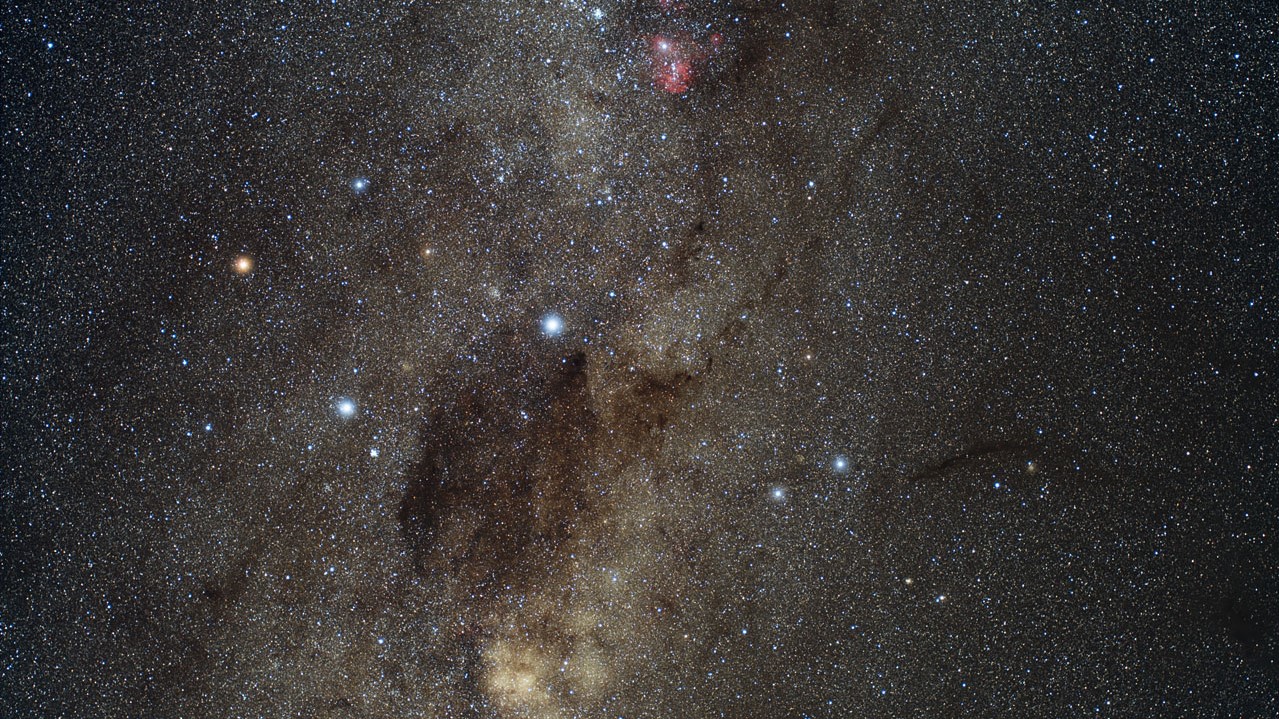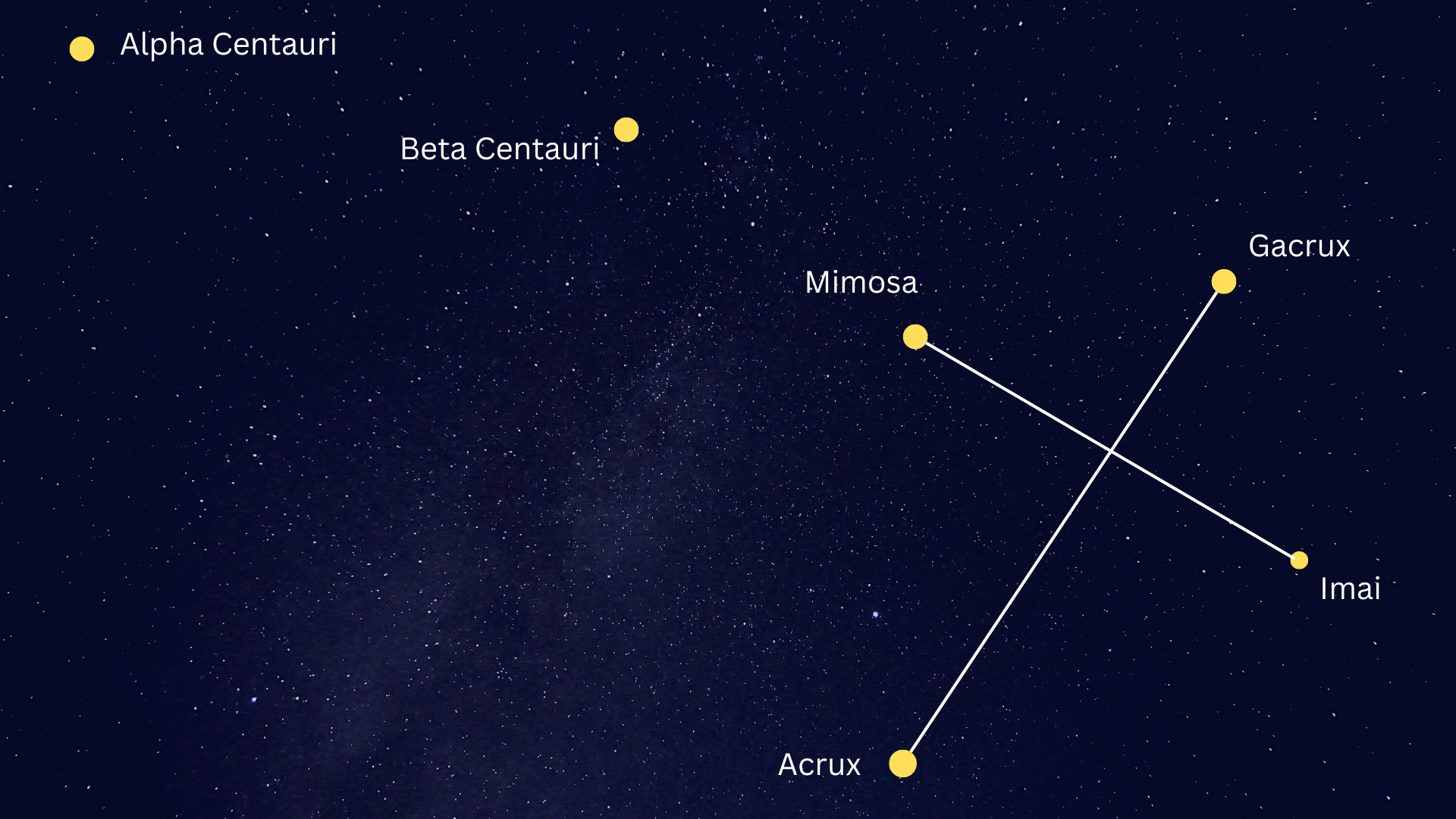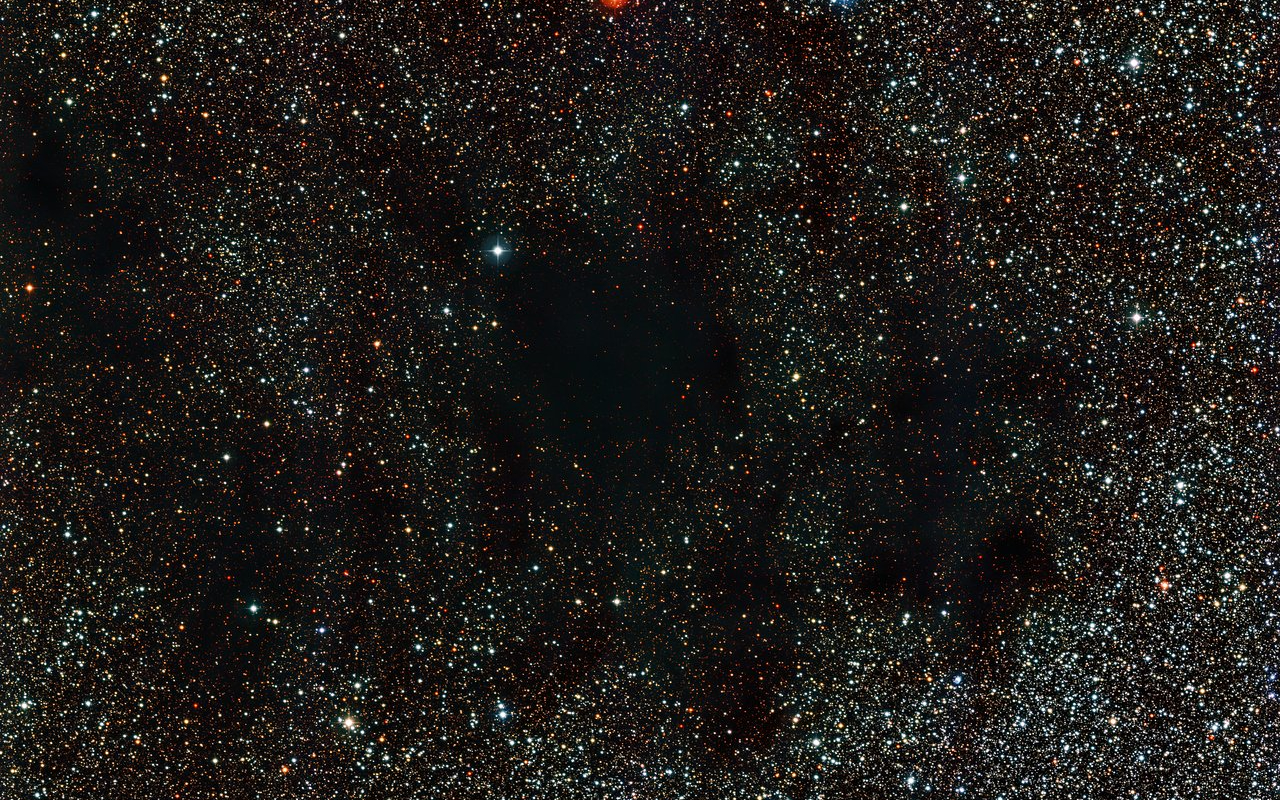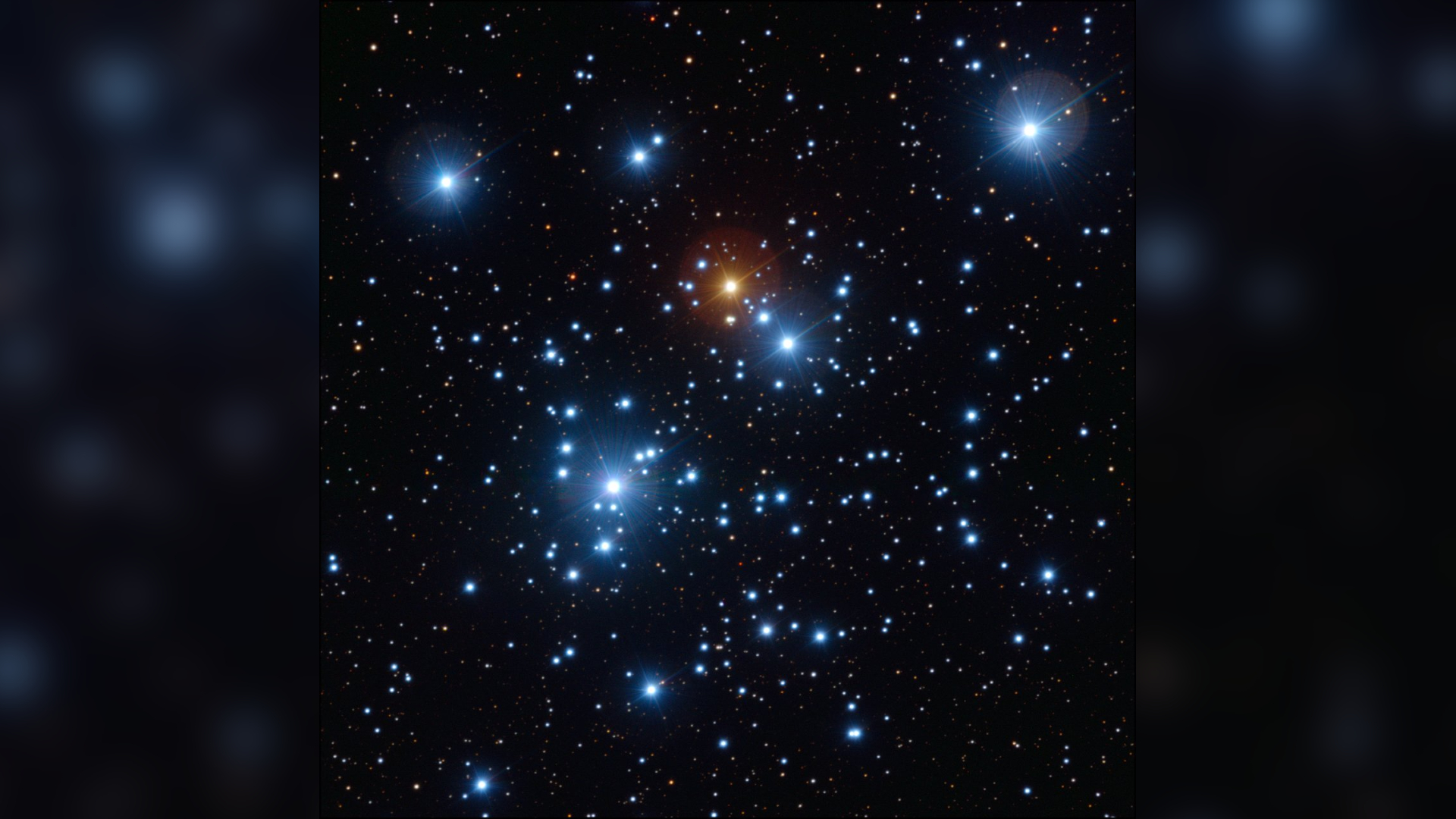Southern Cross: Crux constellation, stars and mythology
The Southern Cross has long been a celestial landmark for intrepid explorers and travelers south of the equator.

The Southern Cross is an asterism made up of the most visible stars in the constellation Crux.
The iconic group of stars is visible mainly from the Southern Hemisphere. Because of its orientation in the night sky, the Southern Cross has historically served as an essential navigational guide: two of its major stars form a line that points to the South Pole. The Southern Cross is also featured in the flags of several Southern Hemisphere countries.
Crux is the smallest of the 88 official constellations defined by the International Astronomical Union (IAU). The Southern Cross is not the entire region of the sky that makes up Crux, but rather just the four (or five) stars that make its iconic cross shape: That's what makes it an asterism.
Related: How many stars are in the universe?
What stars are in the Southern Cross?

The Southern Cross is made up of four or five stars, depending on who you ask. The four main stars, according to Constellation Guide, are Acrux (also known as Alpha Crucis), Mimosa (Beta Crucis), Gacrux (Gamma Crucis) and Imai (Delta Crucis). Acrux is the southernmost star, while Gacrux is the farthest north. Mimosa and Imai form the crossbeam.
Brazil's national flag shows the Southern Cross in reverse compared to the stars on Australia, Samoa, Papua New Guinea and New Zealand's flags. That's because, according to Universidade Federal de Santa Catarina, the Brazilian flag shows the stars across the Southern Hemisphere in a mirror image. Imagine observing the stars over Rio de Janeiro from a fictional place "outside of the sky."
The fifth brightest star in the Crux constellation, Ginan (Epsilon Crucis), is included in some depictions of the Southern Cross: for example, the national flags of Australia, Papua New Guinea, Samoa and Brazil. Ginan appears in the space between Imai and Acrux, not as part of the main cross formation. It's left off of the national flag of New Zealand, which features only the four brightest stars of the cross.
Alpha, beta and delta Crucius — also known as Acrux, Mimosa and Imai — likely share a common origin, wrote Constellation Guide, as they are all made up of massive, hot-burning B-type stars.
Acrux, the brightest and southernmost star in the Southern Cross, is the 13th-brightest star in the night sky with a visual magnitude of +.76, according to a 1966 paper published in the journal Monthly Notes of the Astronomical Society of Southern Africa. The lower a star's visual magnitude is, the brighter that star is. For comparison, the brightest star in Earth's sky is Sirius, with a magnitude of -1.46.
While for magnitude purposes it is considered to be one star, Acrux is actually a multiple star system, according to the Astronomical Society of Southern Africa. While it looks like one star to an unassisted observer on Earth, more sensitive telescopes reveal that it is made up of several components.
What else can you see in the Southern Cross?
Astronomers have identified several other objects of interest in or near the Southern Cross. For the best view of these objects, we recommend using binoculars or a telescope. If you need equipment, our best binoculars and best telescopes guides may help.
In order to find the planetary nebulae, it's helpful to know their magnitude, right ascension (RA) and declination (Dec).
Magnitude tells you how bright an object is as it appears from the Earth. The lower the number of an object's magnitude, the brighter the object. For example, an object of a -1 magnitude is brighter than one with a magnitude of +2.
Right ascension is to the sky what longitude is to the surface of the Earth, corresponding to east and west directions. It's measured in hours, minutes and seconds.
Declination tells you how high an object will rise in the sky. Like Earth's latitude, declination measures north and south. Its units are degrees, arcminutes and arcseconds. There are 60 arcmins in a degree and 60 arcsecs in an arcmin.
The Coalsack Nebula

Approximate distance from Earth: 600 light-years
Location: 12h 50m (right ascension), −62° 30' (declination)
The Coalsack Nebula according to the European Southern Observatory (ESO) forms a conspicuous dark silhouette against the Milky Way. The nebula, wrote the ESO, has been recognizable to people in the southern hemisphere for "as long as our species has existed." That's because it is one of the most prominent objects of its kind visible to the unaided eye — an inky blotch in an otherwise bright area at night. Millions of years from now, the ESO wrote, the Coalsack will end this dark phase and ignite with new stars, flammable just like the dark coal it's named after.
The Jewel Box

Magnitude: +4.2
Approximate distance from Earth: 6,440 light-years
Location: 12h 53m 42s (right ascension), −60° 22.0' (declination)
Another object of interest in the Southern Cross is the Jewel Box, a galactic star cluster located about 6400 light-years away. According to the European Space Agency (ESA) it is approximately 16 million years old, and is just bright enough to be seen with the naked eye. Its nickname dates back to the 1830s and comes from the English astronomer John Herschel (son of astronomer William Herschel), the ESA wrote, because its twinkling blue and orange stars made Herschel think of a piece of exotic jewelry.
How can you find Southern Cross?
According to the IAU, Crux is the smallest of the 88 officially recognized constellations. But it's still easy to spot for viewers in the Southern Hemisphere, especially those more than 35 degrees south where the stars are visible any time of night, all year round. It's even visible some times of year for those in the Northern Hemisphere below about 26 degrees, wrote EarthSky. Hawaii, southern Florida, and some parts of Texas, for example, will see the stars of the cross clear the horizon on clear May evenings.
To spot the Southern Cross, viewers use two "pointer stars," Alpha Centauri and Beta Centauri, wrote The Australian Broadcasting Corporation (the ABC). That's in part how skywatchers can separate the true Southern Cross from a number of false crosses in the night sky.
From the Northern Hemisphere, the cross will generally appear vertical. But in the Southern Hemisphere, according to the ABC, the cross could appear to be lying on its side or upside down depending on the month and the time of night.
The easiest way to make sure you're looking at the right Southern Cross is to use a compass. Look south, follow the Milky Way, and draw a line between the bright pointer stars to find the cross.
How is the Southern Cross used for navigation?
The Southern Cross can be used to point a navigator on the Earth's surface toward the celestial south pole, according to EarthSky. A line drawn from Gacrux at the top of the cross through Acrux at the bottom will point to the south.
Navigators using traditional Polynesian wayfinding techniques also use the stars of the Southern Cross as one of many pointers to the south, according to the Polynesian Voyaging Society.
The cultural significance of the Southern Cross
The Southern Cross asterism appears in multiple national flags, as noted above. The stars were valuable guides to European explorers who left the stars they knew — Polaris and the Big Dipper, for example — to navigate seas in the Southern Hemisphere. The first European to describe the five stars of the Southern Cross, Andrea Corsali, wrote of their beauty and behavior in 1515 for his patrons in the Medici family, according to a 2019 article from Hordern House. Corsali's description provided a resource for centuries of later European explorers.
But the stars were first known by civilizations that far predated the European seafarers: for example, the ABC lists several myths from Indigenous peoples of Australia identifying the stars as part of a wedge-tailed eagle, an emu's head, or a group of trouble-making youngsters. In fact, the IAU recognizes the star Ginan by the name given to it thousands of years ago by the Wardaman people of northern Australia, according to a news article in the Sydney Morning Herald. The Indigenous Knowledge Institute at the University of Melbourne notes that Indigenous Australians used the Southern Cross stars to navigate.
The Maori, the Indigenous people of New Zealand, also named and referred to the stars identified by the IAU as the Southern Cross. The Maori considered the asterism to be the anchor of a celestial canoe, according to Te Aka, a Maori language dictionary.
Incan astronomers associated the same area of the sky with the tinamou, a ground-dwelling, seed-eating bird. In a 1981 paper in the Proceedings of the American Philosophical Society, the author speculates that while the stars of the Southern Cross rose in the sky each year, tinamous likely thrived on the arrival of the rainy season. The cycle of those stars corresponded with the time in which farmers would have been planting their vulnerable seed.
Additional resources
For more on the Southern Cross and traditional Polynesian wayfinding, watch this video of navigator Nainoa Thomson talking about those stars. And to get another insight into why people choose particular stars as constellations and asterisms, check out this article from Science News Explores.
Bibliography
Annab, R. (2020, May 28). Stellar navigation and mathematics. Indigenous Knowledge Institute. https://indigenousknowledge.unimelb.edu.au/curriculum/resources/stellar-navigation-and-mathematics
Blane, D. (2014, February 24). Alpha crucis — double star of the month. ASSA. http://assa.saao.ac.za/sections/double-and-variable-stars/double-stars/news-and-articles/alpha-crucis-double-star-of-the-month/
Corben, P. M. (1966). Photoelectric magnitudes and colours for bright southern stars. Monthly Notes of the Astronomical Society of South Africa, 25, 44. https://ui.adsabs.harvard.edu/abs/1966MNSSA..25...44C
Duarte, P. A. (2008, May 2). Astronomia da bandeira brasileira. Departamento de Geociências da Universidade Federal de Santa Catarina. https://web.archive.org/web/20080502120005/http://www.cfh.ufsc.br/~planetar/textos/astroban.htm
Hook, R. (2015, October 14). A cosmic sackful of black coal—Part of the coalsack nebula in close-up. Www.Eso.Org; European Southern Observatory. https://www.eso.org/public/news/eso1539/
Lomb, N. (2008, July 21). Finding south using the Southern Cross — an essential skill. Observations. https://www.maas.museum/observations/2008/07/21/finding-south-using-the-southern-cross-an-essential-skill/
Mannix, L. (2018, January 16). Southern Cross star given new name to recognise Aboriginal astronomy. The Sydney Morning Herald. https://www.smh.com.au/technology/southern-cross-star-renamed-to-recognise-aboriginal-astronomy-20180116-h0j1yf.html
McClure, B. (2021, April 1). How to see the southern cross from the northern hemisphere | favorite star patterns | earthsky. EarthSky.org. https://earthsky.org/favorite-star-patterns/the-southern-cross-signpost-of-southern-skies/
Meridian pointers to south. Hōkūleʻa. Retrieved October 29, 2022, from https://www.hokulea.com/education-at-sea/polynesian-navigation/polynesian-non-instrument-wayfinding/meridian-pointers-to-south/
Sharkey, C. (2009, October 29). Opening up a colourful cosmic Jewel Box. Www.Spacetelescope.Org; European Space Agency. https://www.spacetelescope.org/news/heic0913/
Southern cross: Guide to south celestial pole — constellation guide. (n.d.). Retrieved October 29, 2022, from https://www.constellation-guide.com/the-southern-cross/
The Constellations. The International Astronomical Union; IAU. Retrieved October 27, 2022, from https://www.iau.org/public/themes/constellations/
Virtual tours » beginner's guide to the night sky(Abc science). (2019). Australian Broadcasting Corporation. https://www.abc.net.au/science/starhunt/tour/virtual/
Waka o tamarēreti, te—Te aka māori dictionary. Waka o Tamarēreti, Te - Te Aka Māori Dictionary. Retrieved October 29, 2022, from https://www.maoridictionary.co.nz/
Join our Space Forums to keep talking space on the latest missions, night sky and more! And if you have a news tip, correction or comment, let us know at: community@space.com.
Get the Space.com Newsletter
Breaking space news, the latest updates on rocket launches, skywatching events and more!

Vicky Stein is a science writer based in California. She has a bachelor's degree in ecology and evolutionary biology from Dartmouth College and a graduate certificate in science writing from the University of California, Santa Cruz (2018). Afterwards, she worked as a news assistant for PBS NewsHour, and now works as a freelancer covering anything from asteroids to zebras. Follow her most recent work (and most recent pictures of nudibranchs) on Twitter.










